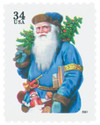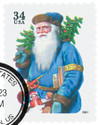
2001 34c Contemporary Christmas: Santa with Horn
# 3538 - 2001 34c Contemporary Christmas: Santa with Horn
$1.00 - $2.95
U.S. #3538
34¢ Santa with Horn
Contemporary Christmas
34¢ Santa with Horn
Contemporary Christmas
Issue Date: October 10, 2001
City: Santa Claus, IN
Quantity: 125,000,000
Printed by: American Packaging Corporation for Sennett Security Products
Printing Method: Photogravure
Perforations: Serpentine Die Cut 10 ¾ x 11
Color: Multicolored
City: Santa Claus, IN
Quantity: 125,000,000
Printed by: American Packaging Corporation for Sennett Security Products
Printing Method: Photogravure
Perforations: Serpentine Die Cut 10 ¾ x 11
Color: Multicolored
The Santa Claus se-tenant stamps portray the familiar holiday character in chromolithographs that date from the 1880s to 1920. The designs were also featured on booklet stamps (U.S. #3541-44).
Our modern Santa Claus has his roots in ancient European customs of giving gifts on a special day in winter. Saint Nicholas, a fourth-century bishop, became the Christian figure associated with holiday gift-giving. The Dutch brought their version of St. Nicholas to America, calling him “Sinterklaas.” English settlers adopted him, pronouncing his name “Santa Claus.”
U.S. #3538
34¢ Santa with Horn
Contemporary Christmas
34¢ Santa with Horn
Contemporary Christmas
Issue Date: October 10, 2001
City: Santa Claus, IN
Quantity: 125,000,000
Printed by: American Packaging Corporation for Sennett Security Products
Printing Method: Photogravure
Perforations: Serpentine Die Cut 10 ¾ x 11
Color: Multicolored
City: Santa Claus, IN
Quantity: 125,000,000
Printed by: American Packaging Corporation for Sennett Security Products
Printing Method: Photogravure
Perforations: Serpentine Die Cut 10 ¾ x 11
Color: Multicolored
The Santa Claus se-tenant stamps portray the familiar holiday character in chromolithographs that date from the 1880s to 1920. The designs were also featured on booklet stamps (U.S. #3541-44).
Our modern Santa Claus has his roots in ancient European customs of giving gifts on a special day in winter. Saint Nicholas, a fourth-century bishop, became the Christian figure associated with holiday gift-giving. The Dutch brought their version of St. Nicholas to America, calling him “Sinterklaas.” English settlers adopted him, pronouncing his name “Santa Claus.”











